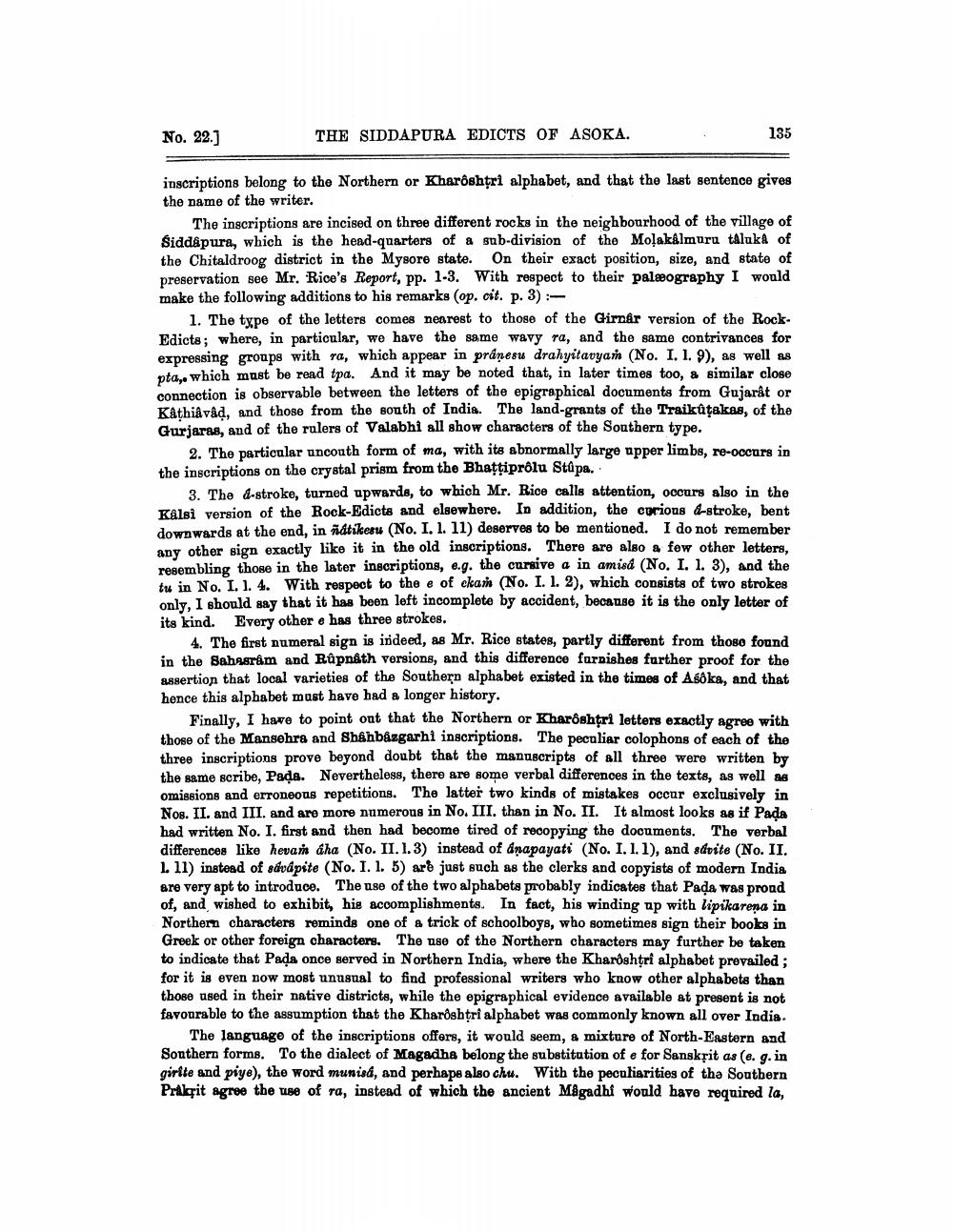________________
No. 22.]
THE SIDDAPURA EDICTS OF ASOKA.
135
inscriptions belong to the Northern or Kharðshtri alphabet, and that the last sentence gives the name of the writer.
The ingcriptions are incised on three different rocks in the neighbourhood of the village of Siddapura, which is the head-quarters of a sub-division of the Moļakálmuru taluka of the Chitaldroog district in the Mysore state. On their exact position, size, and state of preservation see Mr. Rice's Report, pp. 1-3. With respect to their palæography I would make the following additions to his remarks (op. cit. p. 3) :
1. The type of the letters comes nearest to those of the Girnir version of the Rock Edicts; where, in particular, we have the same wavy ra, and the same contrivances for expressing groups with ra, which appear in pránesu drahyitavyan (No. I. 1. 9), as well as pta, which must be read tpa. And it may be noted that, in later times too, & similar close connection is observable between the letters of the epigraphical documents from Gujaråt or Kathiâvâd, and those from the south of India. The land-grants of the Traikutakas, of the Gurjaras, and of the rulers of Valabhi all show characters of the Southern type.
2. The particular uncouth form of ma, with its abnormally large upper limbs, re-occurs in the inscriptions on the crystal prism from the Bhattiprólu Stupa.
3. The 4-stroke, turned upwards, to which Mr. Rice calls attention, occurs also in the Kalsi version of the Rock-Edicts and elsewhere. In addition, the curious 4-stroke, bent downwards at the end, in ñatikesu (No. I. 1. 11) deserves to be mentioned. I do not remember any other sign exactly like it in the old inscriptions. There are also a few other letters. resembling those in the later inscriptions, e.g. the cursive a in amisd (No. I. 1. 3), and the tu in No. 1. 1. 4. With respect to the e of ckan (No. I. 1. 2), which consists of two strokes only, I should say that it has boon left incomplete by accident, because it is the only letter of its kind. Every other e has three strokes.
4. The first numeral sign is indeed, as Mr. Rice states, partly different from those found in the Sahasram and Rûpnåth versions, and this difference fornishes further proof for the assertion that local varieties of the Southern alphabet existed in the times of Asoka, and that hence this alphabet must have had a longer history.
Finally, I have to point out that the Northern or Kharðshtri letters exactly agree with those of the Mansehra and Shahbazgarhi inscriptions. The peculiar colophons of each of the three inscriptions prove beyond doubt that the manuscripts of all three were written by the same scribe, Pada. Nevertheless, there are some verbal differences in the texts, as well as omissions and erroneous repetitions. The latter two kinds of mistakes occur exclusively in Nos. II. and III. and are more numerous in No. III. than in No. II. It almost looks as if Pada had written No. I. first and then had become tired of recopying the documents. The verbal differences like hevan áha (No. II.1.3) instead of anapayati (No. I.1.1), and advite (No. II. 1. 11) instead of adväpite (No. I. 1. 5) are just such as the clerks and copyists of modern India are very apt to introduce. The use of the two alphabets probably indicates that Pada was proud of, and wished to exhibit, his accomplishments. In fact, his winding up with lipikarena in Northern characters reminds one of a trick of schoolboys, who sometimes sign their books in Greek or other foreign characters. The use of the Northern characters may further be taken to indicate that Pada once served in Northern India, where the Kharðshtri alphabet provailed; for it is even now most unusual to find professional writers who know other alphabets than those used in their native districts, while the epigraphical evidence available at present is not favourable to the assumption that the Kharðshtri alphabet was commonly known all over India.
The language of the inscriptions offers, it would seem, & mixture of North-Eastern and Southern forms. To the dialect of Magadha belong the substitution of e for Sanskțit as (e. g. in girite and piye), the word munisd, and perhaps also chu. With the peculiarities of the Southern Prilqit agree the use of ra, instead of which the ancient Màgadhi would have required la,




